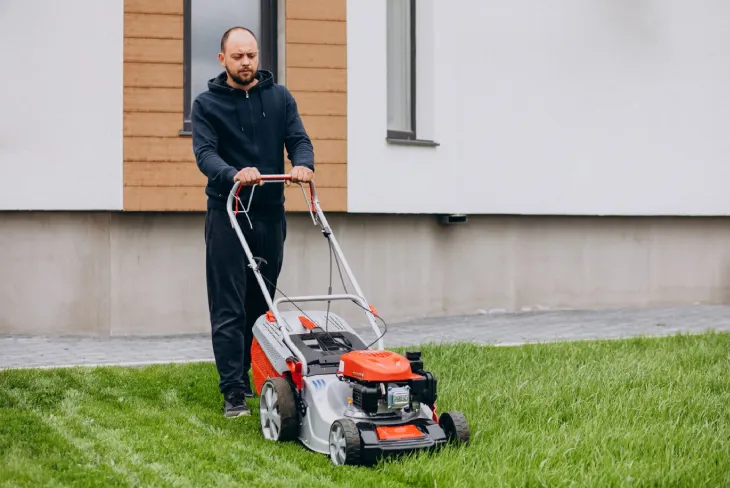How Often Should You Dethatch Your Lawn? It’s a question that many homeowners grapple with, yet few truly understand the importance of this important lawn care task. Picture this: you’ve spent countless hours nurturing your grass, only to find it looking lackluster and unhealthy despite your best efforts. Could dethatching be the missing piece of the puzzle? Let’s dive into the world of lawn care and uncover the truth about dethatching frequency.
Imagine your lawn as a living, breathing organism. Just like any living thing, it needs proper care and maintenance to thrive. Dethatching, the process of removing the layer of dead grass and roots that accumulate between the soil and the living grass, plays a vital role in keeping your lawn healthy and vibrant. But how often should you be doing it?
Many homeowners are left scratching their heads when it comes to dethatching. Some swear by annual dethatching, while others claim it’s only necessary every few years. The truth, as we’ll soon discover, lies somewhere in between.
In this article, we’ll explore the ins and outs of dethatching, helping you determine the ideal frequency for your specific lawn. Get ready to transform your outdoor space into the envy of the neighborhood!
Understanding Dethatch: The Good, The Bad, and The Ugly
Before we jump into the nitty-gritty of dethatching frequency, it’s essential to understand what thatch is and why it matters. Thatch is a layer of dead grass stems, roots, and other organic matter that accumulates between the soil surface and the living grass blades. It’s like a cozy blanket for your lawn, but like most things in life, too much of a good thing can quickly turn sour.
A thin layer of thatch (about 1/2 inch or less) can be beneficial for your lawn. It helps retain moisture, regulate soil temperature, and provide a cushion against foot traffic. However, when thatch builds up to more than 1/2 inch thick, it can spell trouble for your grass.
Excessive thatch can:
- Block water, air, and nutrients from reaching the soil and grassroots
- Harbor pests and diseases
- Create an uneven surface for mowing
- Make your lawn more susceptible to drought and temperature extremes
Think of thatch like cholesterol in the human body. A little bit is necessary for proper function, but too much can lead to serious problems. Just as we need to monitor our cholesterol levels, we need to keep an eye on the thatch in our lawns.
Signs Your Lawn Needs Dethatching
Now that we understand the role of thatch, how can you tell if your lawn is crying out for a good dethatching?
Here are some telltale signs to watch out for:
- Spongy feel: When you walk on your lawn, does it feel springy or spongy underfoot? This could be a sign of excessive thatch.
- Difficulty pushing a screwdriver into the soil: If you struggle to push a screwdriver or your finger into the soil, it might be due to a thick thatch layer.
- Brown patches: Areas of brown, dead grass that don’t green up with watering could indicate thatch problems.
- Water runoff: If you notice water running off instead of soaking into the soil when you water your lawn, thatch might be the culprit.
- Pest problems: An increase in insect activity or disease in your lawn can sometimes be traced back to excessive thatch.
If you’re noticing any of these signs, it might be time to consider dethatching. But before you rush out and start tearing up your lawn, let’s talk about how often you should be performing this task.
The Goldilocks Zone of Dethatching Frequency
When it comes to dethatching frequency, we’re looking for that “just right” balance – not too often, not too seldom. The truth is, there’s no one-size-fits-all answer to how often you should dethatch your lawn.
Several factors come into play, including:
- Grass type
- Soil conditions
- Climate
- Lawn care practices
As a general rule of thumb, most lawns benefit from dethatching every 2-3 years. However, some lawns may need it more frequently, while others can go longer between dethatching sessions.
Let’s break it down by grass type:
- Cool-season grasses (e.g., Kentucky bluegrass, fescue, ryegrass):
- These grasses typically need dethatching every 2-3 years.
- They tend to produce thatch more slowly than warm-season grasses.
- Warm-season grasses (e.g., Bermuda grass, zoysia, St. Augustine):
- These grasses often need dethatching annually or every other year.
- They generally produce thatch more quickly due to their vigorous growth.
Remember, these are just guidelines. The best way to determine if your lawn needs dethatching is to perform a simple thatch test.
The Thatch Test
Performing a thatch test is like giving your lawn a quick health check-up.
Here’s how to do it:
- Use a spade or trowel to remove a small, wedge-shaped piece of your lawn about 2-3 inches deep.
- Examine the cross-section of the sample.
- Measure the layer of thatch between the green grass and the soil surface.
If the thatch layer is more than 1/2 inch thick, it’s time to consider dethatching. If it’s less than that, your lawn is likely doing just fine.
Timing is Everything: When to Dethatch
Just as important as how often you dethatch it when you do it. Timing can make the difference between a successful dethatching job and one that leaves your lawn worse off than before.
For cool-season grasses:
- Early fall or early spring are ideal times to dethatch.
- These periods allow the grass to recover quickly before facing extreme temperatures.
For warm-season grasses:
- Late spring or early summer, when the grass is actively growing, is the best time to dethatch.
- Avoid dethatching during periods of drought or extreme heat.
No matter what type of grass you have, never dethatch when your lawn is dormant or stressed. It’s like asking someone to run a marathon while they’re sick – it’s just not going to end well.
A Step-by-Step Guide
Now that we’ve covered the “when” and “how often,” let’s talk about the “how” of dethatching. While you can hire a professional to do the job, many homeowners choose to tackle it themselves.
Here’s a basic guide to dethatching your lawn:
- Mow your lawn slightly shorter than usual.
- Water the lawn lightly to soften the soil (but don’t soak it).
- Choose your tool: For small lawns, a dethatching rake will do. For larger areas, consider renting a power dethatcher.
- Start at one end of your lawn and work in straight lines, overlapping slightly with each pass.
- Go over the entire lawn in one direction, then repeat in a perpendicular direction for thorough coverage.
- Rake up and remove the thatch you’ve loosened.
- Water your lawn thoroughly after dethatching.
- Apply a thin layer of compost to help the lawn recover.
| Grass Type | Dethatching Frequency | Best Time to Dethatch | Notes |
|---|---|---|---|
| Cool-Season Grasses | Every 2-3 years | Early Spring or Early Fall | Includes Kentucky bluegrass, fescue, and ryegrass. Dethatch when thatch exceeds 1/3 inch. |
| Warm-Season Grasses | Annually or Every 2 Years | Late Spring to Early Summer | Includes Bermuda grass, zoysia, and St. Augustine. Dethatch when thatch exceeds 1/2 inch. |
| General Guidelines | As Needed | Based on Thatch Layer Thickness | Dethatch when the thatch layer exceeds 1/2 inch for warm-season grasses and 1/3 inch for cool-season grasses. |
Remember, dethatching can be tough on your lawn, so be prepared for it to look a bit rough for a week or two afterward. With proper care, it will bounce back greener and healthier than ever.
Preventing Excessive Thatch
While regular dethatching is important, the best approach is to prevent excessive thatch buildup in the first place.
Here are some tips to keep thatch under control:
- Don’t overwater: Excessive moisture can lead to shallow root growth and increased thatch.
- Avoid over-fertilizing: Too much nitrogen can cause rapid grass growth and more thatch.
- Mow regularly: Frequent mowing at the proper height encourages deeper root growth and reduces thatch.
- Aerate annually: Core aeration helps break down thatch and improves soil health.
- Use organic fertilizers: These promote beneficial microorganisms that help break down thatch naturally.
- Consider grasscycling: Leaving grass clippings on the lawn (as long as they’re not too long) can help reduce thatch by adding beneficial organic matter to the soil.
By incorporating these practices into your lawn care routine, you may find that you need to dethatch less frequently.
To Dethatch or Not to Dethatch
Despite its benefits, dethatching isn’t without controversy in the lawn care world. Some experts argue that it’s an unnecessary practice that can do more harm than good if done improperly or too frequently.
Critics of dethatching point out that:
- It can damage healthy grass if done too aggressively.
- It may expose the soil to weed seeds.
- It can stress the lawn, making it more susceptible to disease and pests.
These are valid concerns, which is why it’s important to watch only when necessary and to do it properly. If you’re unsure, consider consulting with a local lawn care professional who can assess your specific situation.
Gentler Options for Your Lawn
If the idea of dethatching seems too harsh for your liking, or if your lawn only has a minor thatch problem, there are some alternatives you can consider:
- Power raking: This is a gentler version of dethatching that removes some thatch without being as aggressive.
- Core aeration: While not a direct substitute for dethatching, regular aeration can help prevent thatch buildup and improve soil health.
- Topdressing: Applying a thin layer of compost or soil can help introduce beneficial microorganisms that break down thatch naturally.
- Vertical mowing involves using a special mower that cuts vertically into the turf, helping break up thatch.
These methods can be used in conjunction with or as alternatives to traditional dethatching, depending on your lawn’s needs.
The Future of Lawn Care
As we become more environmentally conscious, the future of lawn care is shifting towards more sustainable practices. This includes rethinking our approach to thatch management.
Some emerging trends include:
- I am using native grass species that are naturally more resistant to thatch buildup.
- Implementing organic lawn care methods that promote natural thatch decomposition.
- Embracing “imperfect” lawns that may have a bit more thatch but require less intensive maintenance.
- Utilizing smart lawn care technologies that can help monitor thatch levels and soil health.
As these practices become more widespread, we may see a shift in how often dethatching is recommended and how it’s performed.
Conclusion
So, how often should you dethatch your lawn? The answer, as we’ve seen, isn’t straightforward. It depends on a variety of factors unique to your lawn and your local environment. However, by understanding the role of thatch, recognizing the signs of excessive buildup, and implementing good lawn care practices, you can develop a dethatching schedule that keeps your grass healthy and vibrant.
Remember, dethatching is just one piece of the lawn care puzzle. It works best when combined with other good practices like proper mowing, watering, and fertilizing. By taking a holistic approach to lawn care, you can create a beautiful, healthy lawn that’s the envy of the neighborhood – without spending every weekend working on it.
As you start your lawn care journey, don’t be afraid to experiment and adjust your approach. Every lawn is unique, and what works for your neighbor might not work for you. Pay attention to how your grass responds to different treatments and adjust accordingly. With a little patience and persistence, you’ll find the perfect balance for your lawn, creating a lush, green oasis that you can enjoy for years to come.




No Comment! Be the first one.